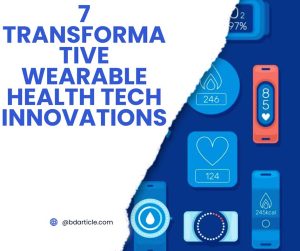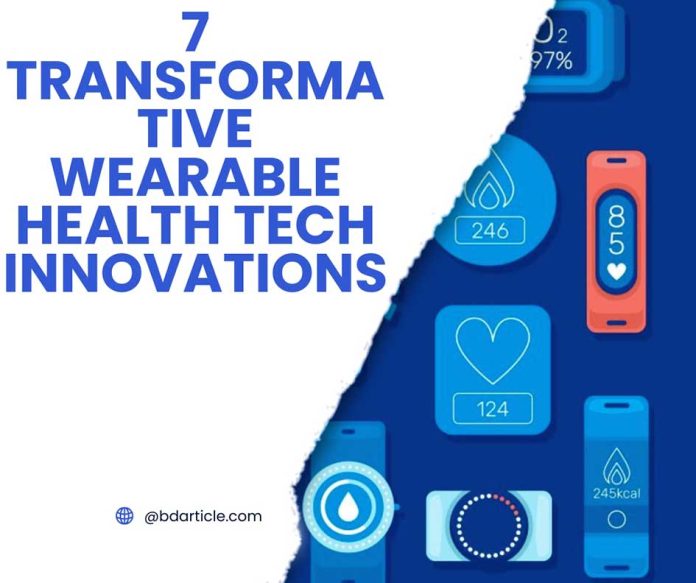Wearable health tech innovations are causing a revolution in the healthcare sector, giving individuals and medical experts the power to keep an eye on, identify, and handle health issues as they happen. These steps blend state-of-the-art tech with everyday ease of use, resulting in gadgets that check vital signs, spot problems, and boost the effectiveness of patient care. We’ll look at some game-changing examples, discuss how they might make a difference, and check out their strong points and weak spots.

The Evolution of Wearable Health Tech
Health-related wearable tech has made big strides since its first appearance. At first, it was just fitness trackers, but now it includes wearable health monitors that can monitor blood pressure, sugar levels, and even heart issues. Improved sensors, connecting methods, and AI-powered data crunching have pushed this growth forward. Below, we’ll dig into seven of this area’s most transformative new ideas.
-
Smartwatches with Health Monitoring Features
Smartwatches have transformed from fancy gadgets to key tools in wearable technology in healthcare. The Apple and Samsung Galaxy Watch can track heart rate and blood oxygen and even take ECG readings. These top wearable health devices warn users about problems like atrial fibrillation, helping them spot dangerous conditions.
Impact:
- Empower users to manage their health proactively.
- Reduce dependency on in-clinic checkups for routine monitoring.
-
Continuous Glucose Monitoring (CGM) Devices
People with diabetes can use devices from companies like Dexcom and Abbott that constantly monitor glucose levels. These gadgets put tiny sensors under the skin to give up-to-the-minute glucose readings. When linked to phone apps, these monitors make handling blood sugar easier and more precise without being too invasive.
Wearable health tech innovations examples:
- Dexcom G6
- FreeStyle Libre
Impact:
- Improve the quality of life for diabetes patients.
- Facilitate better treatment adherence.
-
Wearable Blood Pressure Monitors
Regular blood pressure cuffs are big and not practical for daily use. Wearable health monitoring devices like Omron HeartGuide fix this problem by integrating BP tracking into a smartwatch. These gadgets keep an eye on your health around the clock, which helps people with high blood pressure take better care of themselves.
Future of wearable technology in healthcare:
- Make early hypertension detection more accessible.
- Aid in personalized treatment planning.
-
Smart Rings for Sleep and Recovery Tracking
Devices like the Oura Ring are redefining how we understand sleep and recovery. These top wearable health devices monitor heart rate variability (HRV), temperature, and sleep patterns. Insights from such devices improve individual health outcomes and inform broader research in sleep medicine.
Advantages:
- Promote better sleep hygiene.
- Help users optimize physical and mental recovery.
-
Remote ECG Monitors
Portable ECG monitors like Zio by iRhythm give in-depth looks at heart activity over long stretches. Unlike old-school ECGs, these gadgets are light and easy to carry, so patients can go about their day while being checked.
Example:
- Zio Patch
Wearable technology in healthcare scholarly articles suggests these devices significantly improve diagnostic accuracy for arrhythmias.
-
Smart Clothing and Patches
Clever outfits and stick-on patches are changing the game wearable technology in healthcare examples. Products such as Hexoskin’s brainy shirts and Biostrap’s adhesive sensors build measuring tools into fabric or sticky materials. These gadgets keep tabs on things like breathing, muscle use, and even how much water is in your body.
Impact:
- Enhance athletic performance.
- Provide real-time health data for clinical studies.
-
AR Glasses for Enhanced Patient Care
AR glasses are changing how doctors work. Tools like Microsoft HoloLens let surgeons see 3D models of body parts during operations, which helps them be more exact. These glasses could also make it easier for doctors to advise far away.
What’s next for wearable tech in healthcare:
- To make medical training and education better.
- To improve how patients do by tailoring treatments.
Problems and Downsides
Even though new wearable health tech offers much, it’s not all good news.
Downsides of wearable tech in healthcare:
- Privacy Worries: The info these wearables collect often ends up in the cloud, where it might not be safe.
- Not Always Right: Some gadgets might give wrong or mixed-up readings when conditions aren’t perfect.
- Price: The best devices often cost a lot, so people can’t get them without much money.
Balancing these challenges with advancements will require ongoing collaboration between wearable medical device companies and regulatory bodies.
The Role of Data and Analytics
Wearable devices create huge amounts of data that can improve healthcare. But to use this data well, you need smart AI systems and safe ways to handle it. Regarding Bootstrapping vs. Venture Capital Pros and Cons, new companies in this field often turn to venture capital. This helps them grow their new ideas while following the rules.
The future of wearable technology in healthcare is bright, with trends showing a move towards more personalized, compatible, and integrated solutions with other smart devices. Progress in AI nanotechnology and materials that work well with the body will lead to even more advanced wearable health monitoring devices.
New Ideas on the Horizon:
- Tiny robots to check health from inside the body.
- Sensors that can be put inside the body for non-stop tracking.
- Systems powered by AI to spot diseases like cancer.
External Resources
To learn more about wearable health tech innovations, explore:
Conclusion
Wearable health tech innovations pave the way for a more connected and proactive healthcare ecosystem. These devices, from smart watches to glasses that add digital info to what we see, are changing how we monitor and care for our health. While issues like cost and data safety remain, the benefits far outweigh the disadvantages. By bringing technology and healthcare closer together, these new ideas have the potential to make everyone healthier.
#Wearable_health_tech_innovations #Wearable_health_monitoring_devices #Wearable_technology_in_healthcare_examples

